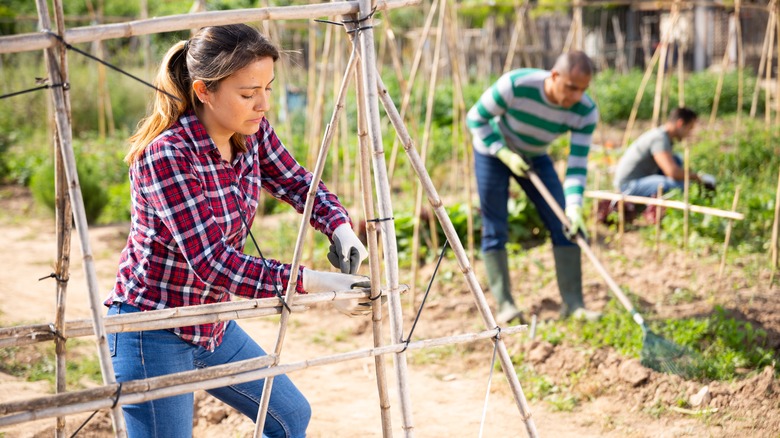The Clever Way You Should Be Reusing Sunflower Stalks In The Garden
Sunflowers (Helianthus annuus) are superstars in the garden thanks to their massive flower heads. Unfortunately, many types of sunflowers only grow one large flower head on top of a tall thick stalk, and then die back after that flower has faded. You don't have to immediately compost your sunflowers after they die, however — their stalks can actually make ideal supports for other plants.
Trellises, stakes, and other supports are invaluable in the garden. Not only does staking tall and lanky plants prevent their stems from breaking and killing the plant, but staking can also keep vining plants like cucumbers and tomatoes growing vertically instead of sprawling on the ground. This both gives you more space for other plants and protects your vines from soil borne pathogens. Taller varieties of nonbranching, also called single stem, sunflowers like the 'Procut' and 'Sunrich' series are the best types of sunflowers to use as garden supports, thanks to their single straight stem which often reaches heights over 6 feet. They are also surprisingly fast growing for how large they can get, often reaching maturity in under 70 days.
Growing and saving sunflower stalks
Turning sunflower plants that have passed their prime into garden supports is a surprisingly simple process. After your sunflowers have bloomed and the flowers are beginning to fade, you can cut the stalks at the base of the stem and remove any remaining flower heads. Leave the stalks in a dry sunny place for about six weeks so they can fully dry out. After about six weeks, your sunflower stalks should be dry and ready to use. Use these homegrown sunflower stakes the same way you would bamboo or plastic stakes.
If you haven't grown sunflowers before and want to give them a try, they grow readily from seed and are generally considered beginner-friendly plants. You can simply direct sow seeds after the last frost of the year and provide them with some supplemental watering when they are young. Sunflowers are quite drought tolerant once they are established. As long as you don't make common avoidable mistakes when growing sunflowers, like overwatering them or not giving them enough sun, they should thrive and quickly mature with little effort.
Using sunflower supports in the garden
There are a multitude of ways your homegrown sunflower stakes can help in the garden. You can easily use a single stake to support a leaning pepper plant by just driving your dried sunflower stalk several inches into the soil and then tying the pepper plant to it. Sunflower stalks can also be used for the trellis-weaving technique for tomato plants called a Florida weave. For this method you plant tomatoes in between tall stakes and weave string between the stakes to hold the plants in place.
You can also create more elaborate supports by lashing the stakes together using twine or string to create a DIY trellis on a budget. Much like with DIY bamboo trellises, these can easily support peas, beans, or even cucumbers. You can build a variety of different trellis styles this way, from a classic teepee trellis made of three or four stakes that are tied together at the top, to more elaborate structures like lattices which have both vertical and horizontal supports. Sunflower stalks are naturally biodegradable so they can easily be composted at the end of the season if they're looking a bit worse for wear.

